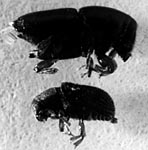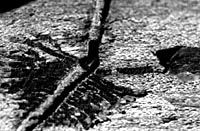 FS-01420
FS-01420Reviewed 1994
![]()
 FS-01420
FS-01420
Reviewed 1994
![]()
The native elm bark beetle (Hylurgopinus rufipes) is a serious pest of American, Siberian, and red elms throughout Minnesota. While it occurs along with the smaller European elm bark beetle (Scolytus multistriatus) in the southern one-third of the state, it is normally the exclusive vector of Dutch elm disease, Ophiostoma (Ceratocystis ) ulmi, in the northern two-thirds of Minnesota.
Identification: Adult -Brownish-black, about 1/8" (2–3.5 mm.) long and body is covered with short, stiff, yellow hairs; the wings (elytra) are deeply pitted (Figure 1).

Figure 1. Adult European elm bark beetle (top) and native elm bark beetle (bottom).
Larvae Small, white grubs found beneath the bark of diseased elms. These are easily confused with other bark beetle grubs such as the smaller European elm bark beetle. Galleries - The egg laying galleries are generally horizontal and run across the wood grain (Figure 2). The smaller larval tunnels coming off the main egg-laying gallery run with the wood grain. This is the most consistent field diagnostic characteristic for native elm bark beetle. Gallery construction is directly opposite for the smaller European elm bark beetle which forms egg-laying galleries vertically (with the wood grain) and has larval galleries running across the wood grain.

Figure 2. Native elm bark beetle gallery with adult and larvae.
Life History: There is usually one generation per year, though in some years a partial second generation occurs. Generally, beetles overwinter as adults at the base of healthy elm trees. In spring (mid-late April), adults emerge, fly to the tops of healthy elms and begin feeding, often on the same trees in which they overwintered. After feeding, beetles seek dead, dying, and/or diseased elms, broken limbs, or recently cut logs in which to breed and construct egg-laying galleries.
Larvae mature underneath the bark, pupate and emerge as adults in July and August. Newly emerging adults, often carrying Dutch elm disease spores, feed on healthy elms. By late September, beetles enter the bark at the tree base (generally below 6 feet) and root flares to construct overwintering sites (Figure 3). Although Dutch elm disease transmission is most likely to occur during spring/summer feeding, it may also take place during overwintering site preparation in healthy elms.
Summer-emerging native elm bark beetles aren't generally attracted to dead, dying, or unhealthy elms for breeding. However, when large numbers of dead, dying, and/or diseased elms are present in an area, for example from poor sanitation practices, emerging beetles will construct galleries and lay eggs. A partial second generation results as grubs grow until cold temperatures retard their development. They winter as nearly full-grown larvae, then mature the following spring and emerge as adults.
Damage: Little or no direct physical damage is done to the tree by beetle feeding or their boring for overwintering sites. However, beetles carrying disease spores can transmit Dutch elm disease during feeding or boring activity.
| Overwintering Adults |
Active Adults |
Larvae |
Active Adults |
Overwintering Adults | |||||||
| JAN | FEB | MAR | APR | MAY | JUNE | JULY | AUG | SEPT | OCT | NOV | DEC |
| Overwintering Larvae | |||||||||||
Figure 3. Native elm bark beetle life history calendar.
1. Sanitation: Proper sanitation is the basis for native elm bark beetle management programs. Prompt removal and disposal of dead and dying elms, debarking cut elm wood and stumps, as well as pruning dead branches is essential to reducing bark beetle breeding sites. If barked elm wood can't be immediately buried, burned, chipped, or debarked, material can be treated with 0.5% (active ingredient) chlorpyrifos until disposal takes place.
Although summer emerging adults are not generally attracted to dead, dying or diseased elms, it is still important that prompt removal of these trees takes place in late summer and fall. If a high percentage of trees in an area are dead, dying, or diseased, beetles may use these trees as breeding sites producing a partial second generation of beetles. This will complicate control timing practices the following season.
2. Chemical Control: Because native elm bark beetles usually overwinter as adults in healthy elm trees, fall sanitation efforts will not affect this stage of the beetle's lifecycle. They can, however, be controlled through chemical applications. Chemical control should supplement the sanitation management program, not replace it; sanitation efforts are still the best way to reduce beetle numbers and Dutch elm disease incidence.
Chlorpyrifos applications to elm trunks in mid-September are effective for killing beetles before they bore into healthy elms to construct overwintering sites. Chemical applications should be made up to a height of 6 feet (see sampling procedures) and should also include all above-ground root flares; thorough coverage is essential. Applications made after late September will be effective in controlling overwintering beetles from emerging and transmitting Dutch elm disease the following spring. However, because beetles are capable of transmitting Dutch elm disease in September while making overwintering sites in healthy elms, chemical controls in fall prior to beetle penetration are recommended over those applied after beetle penetration.
Although trunk applications can be used on individual trees to reduce their chance of contracting Dutch elm disease, these programs are most effective when done on a community-wide basis to reduce overall beetle populations. Crown spraying of elms to reduce beetle populations is not recommended, nor is it as effective as trunk treatments for native elm bark beetle control.
3. Sampling: In accordance with proper pest management techniques, before any chemical control measures are implemented, sampling for presence of native elm bark beetles must be done. Efforts should concentrate primarily in wooded areas (parks, wood lots, river bottoms, etc.) in the southern third of the state. Both wooded areas and boulevard trees are susceptible to attack in the northern portions of the state.
Sampling consists of determining the number of dust boring piles that beetles make while selecting overwintering sites at the base of healthy elm trees in late September into October (Figure 4). The fine, red-brown dust piles can also be counted in mid-late April. Use the following guidelines to determine if chemical control measures are warranted:
a. In the defined control zone (area), four separate locations from within each square mile should be selected. From each of the four selected locations in that square mile, twenty healthy elm trees should be sampled. b. Counts should be made on the lower 12 inches of each trunk (including visible root flares); however, if dust piles are found at the 1 foot level, sampling should continue up to 6 feet. c. The average number of dust boring piles per tree within each selected sample area of the control zone is then calculated. If the average number of dust boring piles is greater than 10 per tree and the previous year's disease incidence was greater than 5 percent, trunk spraying is recommended. If the previous year's disease incidence was less than 5%, spraying measures should be taken only if average dust pile numbers per tree are greater than 20. This approach is based on the rationale that if disease incidence in an area is low, beetles will have a much harder time coming in contact with disease spores, and chances for transmission will be diminished. d. Chemical sprays should be applied only to the height at which dust boring piles are found. If dust piles are present at 6 feet, then sprays should be applied up to the 6-foot level. Conversely, if piles were only found at 1 foot, then spraying the areas below the 1-foot level is all that is needed.

Figure 4. Dust boring piles at base of healthy elm trees.
4. Pruning: If at all possible, pruning should not be attempted during the growing season. Overwintering native elm bark beetles are attracted by dying and cut elms in May and early June; pruning should not be performed at this time. However, because summer emerging adults are generally not attracted to cut or dying elms, pruning in August or September is acceptable if pruning must be done during the growing season. This applies to areas where native elm bark beetle is the only Dutch elm disease vector. It has also been demonstrated that wound dressings significantly reduce attractions of native elm bark beetles to elm injuries. Thus, if pruning or storm damage occurs during the growing season, exposed wood should be covered with an appropriate wound dressing.
Mark E. Ascerno and Robert P. Wawrzynski
Entomology
![]()
Produced by Communication and Educational Technology Services, University of Minnesota Extension Service.
In accordance with the Americans with Disabilities Act, this material is available in alternative formats upon request. Please contact your University of Minnesota Extension Service office or the Distribution Center at (800) 876-8636.
The University of Minnesota Extension Service is committed to the policy that all persons shall have equal access to its programs, facilities, and employment without regard to race, color, creed, religion, national origin, sex, age, marital status, disability, public assistance status, veteran status, or sexual orientation.